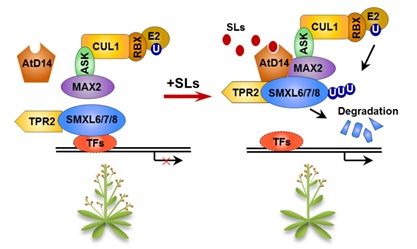Strigolactones (SLs) are a group of carotenoid-derived lactones produced by plants and mediate symbiosis with arbuscular mycorrhizal fungi and can trigger germination of parasitic plants.
More recently, SLs have been reported to function as root-to-shoot phytohormones that suppress shoot branching by inhibiting the outgrowth of axillary buds. In rice (
Oryza sativa), the DWARF3 (D3) F-box protein acts with the SL receptor
DWARF14 (D14) as part of an Skp-Cullin-F-box complex in ubiquitin-mediated proteolysis. The SL signaling pathway requires the degradation of DWARF53 (D53), mediated by a complex including D14 and D3, which in turn release the repression of downstream target genes. However, in
Arabidopsis thaliana, the components and mechanism of SL signaling involving the D3 ortholog MORE AXILLARY GROWTH2 (MAX2) are unknown.
The group of Prof. LI Jiayang from the Institute of Genetics and Developmental Biology, Chinese Academy of Science reported that the SL-dependent regulation of shoot branching in Arabidopsis requires three D53-like proteins, SUPPRESSOR OF MORE AXILLARY GROWTH2-LIKE6 (SMXL6), SMXL7, and SMXL8. The smxl6 smxl7 smxl8 triple mutant suppresses the highly branched phenotypes of max2 and the SL-deficient mutant max3. Overexpression of a mutant form of SMXL6 that is resistant to SL-induced ubiquitination and degradation enhances shoot branching. Exogenous application of the SL analog rac-GR24 causes ubiquitination and degradation of SMXL6, 7, and 8. D53-like SMXLs form complexes with MAX2 and TOPLESS-RELATED PROTEIN2 (TPR2) and interact with D14 in a GR24-responsive manner.
Further study shows that D53-like SMXLs exhibit TPR2-dependent transcriptional repression activity and repress the expression of BRANCHED1 (BRC1).
These findings reveal that in Arabidopsis, D53-like SMXLs act with TPR2 to repress transcription and so allow lateral bud outgrowth but that SL-induced degradation of D53-like proteins activates transcription to inhibit outgrowth.
This work entitled “Strigolactone signaling in Arabidopsis regulates shoot development by targeting D53-like SMXL repressor proteins for ubiquitination and degradation”has been published online in
The Plant Cell on Nov. 7, 2015 (
doi:10.1105/tpc.15.00605), with WANG Lei and Dr. WANG Bing from LI Jiayang’s group as the co-first authors. Prof. Steven M. Smith from the University of Tasmania has made great contribution to this project. This research was financially supported by National Natural Science Foundation of China and Chinese Academy of Sciences (The International Fellowship for Visiting Scientists).
Figure. A model of the SL signaling complex in Arabidopsis. (Image by IGDB)
The proposed model includes SL-dependent interaction of Arabidopsis D14 with both MAX2 and SMXL proteins, although the sequence in which these interactions occur is unknown. It is not known if BRC1 is a direct or indirect target of this SL signaling mechanism. ASK, CUL1, RBX, and E2 are components of the ubiquitination complex. U, Ubiquitin; TFs, transcription factors (unidentified).
AUTHOR CONTACT:
Li Jiayang
 Figure. A model of the SL signaling complex in Arabidopsis. (Image by IGDB)The proposed model includes SL-dependent interaction of Arabidopsis D14 with both MAX2 and SMXL proteins, although the sequence in which these interactions occur is unknown. It is not known if BRC1 is a direct or indirect target of this SL signaling mechanism. ASK, CUL1, RBX, and E2 are components of the ubiquitination complex. U, Ubiquitin; TFs, transcription factors (unidentified).AUTHOR CONTACT:Li JiayangInstitute of Genetics and Developmental Biology, Chinese Academy of Sciences, Beijing, China.E-mail: jyli@genetics.ac.cn
Figure. A model of the SL signaling complex in Arabidopsis. (Image by IGDB)The proposed model includes SL-dependent interaction of Arabidopsis D14 with both MAX2 and SMXL proteins, although the sequence in which these interactions occur is unknown. It is not known if BRC1 is a direct or indirect target of this SL signaling mechanism. ASK, CUL1, RBX, and E2 are components of the ubiquitination complex. U, Ubiquitin; TFs, transcription factors (unidentified).AUTHOR CONTACT:Li JiayangInstitute of Genetics and Developmental Biology, Chinese Academy of Sciences, Beijing, China.E-mail: jyli@genetics.ac.cn CAS
CAS
 中文
中文




.png)
